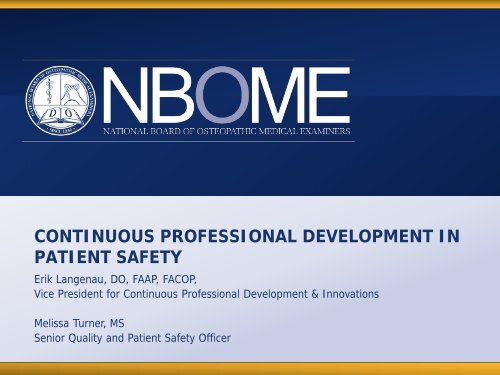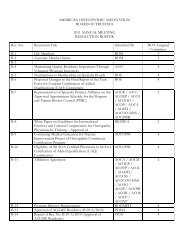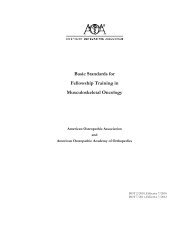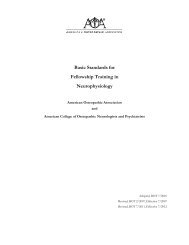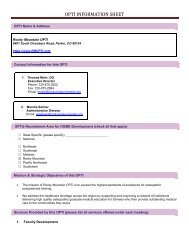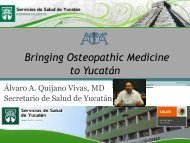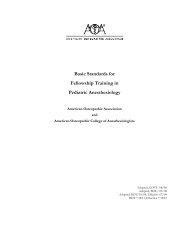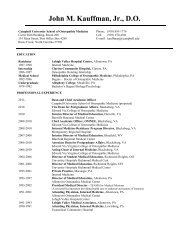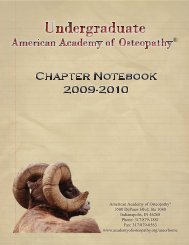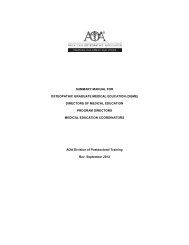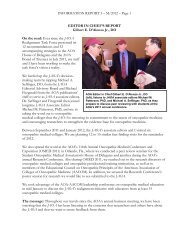"Continuous Professional Development in Patient Safety" - Erik ...
"Continuous Professional Development in Patient Safety" - Erik ...
"Continuous Professional Development in Patient Safety" - Erik ...
You also want an ePaper? Increase the reach of your titles
YUMPU automatically turns print PDFs into web optimized ePapers that Google loves.
CONTINUOUS PROFESSIONAL DEVELOPMENT IN<br />
PATIENT SAFETY<br />
<strong>Erik</strong> Langenau, DO, FAAP, FACOP,<br />
Vice President for <strong>Cont<strong>in</strong>uous</strong> <strong>Professional</strong> <strong>Development</strong> & Innovations<br />
Melissa Turner, MS<br />
Senior Quality and <strong>Patient</strong> Safety Officer<br />
www.nbome.org<br />
© 2012 NBOME
<strong>Cont<strong>in</strong>uous</strong> <strong>Professional</strong> <strong>Development</strong> <strong>in</strong> <strong>Patient</strong> Safety<br />
• Disclosures<br />
– None<br />
• Agenda<br />
– What are the elements of <strong>Patient</strong> Safety? (Melissa Turner)<br />
– What cont<strong>in</strong>uous professional development programs<br />
address <strong>Patient</strong> Safety? (<strong>Erik</strong> Langenau)<br />
www.nbome.org<br />
© 2012 NBOME
<strong>Cont<strong>in</strong>uous</strong> <strong>Professional</strong> <strong>Development</strong> <strong>in</strong> <strong>Patient</strong> Safety<br />
Medical Error and <strong>Patient</strong> Safety<br />
• 1 <strong>in</strong> 25 hospital patients susta<strong>in</strong>s <strong>in</strong>jury related to<br />
medical error<br />
• Medical errors account for 44,000-98,000 deaths<br />
per year<br />
• By low US mortality estimates, medical error is<br />
the 8 th lead<strong>in</strong>g cause of death<br />
The Institute of Medic<strong>in</strong>e: Achiev<strong>in</strong>g a New Standard for Care (2004). IOM; 2010. Available at<br />
http://www.nap.edu/openbook.php?record_id=10863&page=30. Last accessed December 2012.<br />
www.nbome.org<br />
© 2012 NBOME
<strong>Cont<strong>in</strong>uous</strong> <strong>Professional</strong> <strong>Development</strong> <strong>in</strong> <strong>Patient</strong> Safety<br />
Medical Error and Healthcare Costs<br />
• Medical errors cost $17-29 billion per year <strong>in</strong><br />
expense, lost worker productivity and disability<br />
• US healthcare expense ris<strong>in</strong>g 7% per year,<br />
patient safety improv<strong>in</strong>g by 1% per year<br />
Reduc<strong>in</strong>g Errors <strong>in</strong> Healthcare: Translat<strong>in</strong>g Research Into Practice (2000). The Agency for Healthcare<br />
Research and Quality (AHRQ); 2000. Available at http://www.ahrq.gov/qual/errors.htm. Last accessed<br />
December 2012.<br />
www.nbome.org<br />
© 2012 NBOME
<strong>Cont<strong>in</strong>uous</strong> <strong>Professional</strong> <strong>Development</strong> <strong>in</strong> <strong>Patient</strong> Safety<br />
Types of medical error<br />
• Diagnostic process error result<strong>in</strong>g <strong>in</strong><br />
– near miss, misdiagnosis, harm<br />
• Diagnostic error result<strong>in</strong>g <strong>in</strong><br />
– Misdiagnosis, missed diagnosis, delayed diagnosis<br />
• Adverse outcome<br />
www.nbome.org<br />
© 2012 NBOME
<strong>Cont<strong>in</strong>uous</strong> <strong>Professional</strong> <strong>Development</strong> <strong>in</strong> <strong>Patient</strong> Safety<br />
• How do we know?<br />
• Why do we measure?<br />
www.nbome.org<br />
© 2012 NBOME
QUALITY: PATIENT-CENTERED, TIMELY CARE<br />
Doctor–<strong>Patient</strong> Communication: Doctor Listened Carefully,<br />
Expla<strong>in</strong>ed Th<strong>in</strong>gs Clearly, Respected What They Had to Say,<br />
and Spent Enough Time with Them<br />
Percent of adults age 18 and older reported “always”<br />
100<br />
U.S. average<br />
75<br />
54<br />
57 57 57 58 57<br />
50<br />
25<br />
0<br />
2002^ 2003 2004^ 2005 2006 2007<br />
^ Denotes years <strong>in</strong> 2006 and 2008 National Scorecards.<br />
Data: U.S. average—Medical Expenditure Panel Survey (AHRQ 2010)<br />
www.nbome.org<br />
© 2012 NBOME<br />
Source: Commonwealth Fund National Scorecard on U.S. Health System Performance, 2011. 7
<strong>Cont<strong>in</strong>uous</strong> <strong>Professional</strong> <strong>Development</strong> <strong>in</strong> <strong>Patient</strong> Safety<br />
<strong>Cont<strong>in</strong>uous</strong> <strong>Professional</strong> <strong>Development</strong> Programs<br />
Best Practices<br />
<strong>Patient</strong> Safety<br />
<strong>Cont<strong>in</strong>uous</strong> <strong>Professional</strong> <strong>Development</strong><br />
(CPD) Programs<br />
www.nbome.org<br />
© 2012 NBOME
<strong>Cont<strong>in</strong>uous</strong> <strong>Professional</strong> <strong>Development</strong> <strong>in</strong> <strong>Patient</strong> Safety<br />
Board Certified Physicians:<br />
Osteopathic <strong>Cont<strong>in</strong>uous</strong> Certification (OCC)<br />
Ma<strong>in</strong>tenance of Certification (MOC)<br />
FSMB-MOL AOA-OCC ABMS-MOC<br />
1. Unrestricted Licensure 1. Licensure & <strong>Professional</strong> Stand<strong>in</strong>g<br />
1. Reflective Lifelong<br />
Learn<strong>in</strong>g<br />
2. The assessment of<br />
knowledge & skills<br />
2. Lifelong Learn<strong>in</strong>g/CME 2. Lifelong Learn<strong>in</strong>g & Selfassessment<br />
3. Cognitive Assessment 3. Cognitive Expertise<br />
3. Performance <strong>in</strong> Practice 4. Practice Performance<br />
Assessment & Improvement<br />
4. Practice Performance Assessment<br />
5. AOA Membership<br />
www.nbome.org<br />
© 2012 NBOME
<strong>Cont<strong>in</strong>uous</strong> <strong>Professional</strong> <strong>Development</strong> <strong>in</strong> <strong>Patient</strong> Safety<br />
Board Certified Physicians:<br />
Osteopathic <strong>Cont<strong>in</strong>uous</strong> Certification (OCC)<br />
Ma<strong>in</strong>tenance of Certification (MOC)<br />
FSMB-MOL AOA-OCC ABMS-MOC<br />
1. Unrestricted Licensure 1. Licensure & <strong>Professional</strong> Stand<strong>in</strong>g<br />
1. Reflective Lifelong<br />
Learn<strong>in</strong>g<br />
2. The assessment of<br />
knowledge & skills<br />
2. Lifelong Learn<strong>in</strong>g/CME 2. Lifelong Learn<strong>in</strong>g & Selfassessment<br />
3. Cognitive Assessment 3. Cognitive Expertise<br />
3. Performance <strong>in</strong> Practice 4. Practice Performance<br />
Assessment & Improvement<br />
4. Practice Performance Assessment<br />
5. AOA Membership<br />
www.nbome.org<br />
© 2012 NBOME
<strong>Cont<strong>in</strong>uous</strong> <strong>Professional</strong> <strong>Development</strong> <strong>in</strong> <strong>Patient</strong> Safety<br />
Examples of CME programs<br />
• Conferences<br />
– Annual Health Care Quality & <strong>Patient</strong> Safety Conference<br />
– Annual National <strong>Patient</strong> Safety Foundation (NPSF)<br />
<strong>Patient</strong> Safety Congress<br />
• Knowledge exam<strong>in</strong>ations<br />
– Pediatrics Review and Education Program (PREP)<br />
– <strong>Cont<strong>in</strong>uous</strong> Osteopathic Learn<strong>in</strong>g Assessment (COLA)<br />
• Onl<strong>in</strong>e courses<br />
www.nbome.org<br />
© 2012 NBOME
<strong>Cont<strong>in</strong>uous</strong> <strong>Professional</strong> <strong>Development</strong> <strong>in</strong> <strong>Patient</strong> Safety<br />
Examples of Practice Improvement Programs<br />
• Simulation<br />
– Practical Exam / Standardized <strong>Patient</strong>s<br />
• AOBNMM Oral and Practical Exam<br />
– Simulations (Mannequ<strong>in</strong>, Part-task)<br />
• ACLS / BLS<br />
• ABA (Anesthesiology) Simulation Exams<br />
• Fundamentals of Laparoscopic Surgery (FLS)<br />
– Computer–Based Simulation<br />
• ABFM Self-Assessment Module (SAM)<br />
http://www.wiser.pitt.edu/sites/wiser/moca<br />
www.sciencedirect.com<br />
www.nbome.org<br />
© 2012 NBOME
<strong>Cont<strong>in</strong>uous</strong> <strong>Professional</strong> <strong>Development</strong> <strong>in</strong> <strong>Patient</strong> Safety<br />
Examples of Practice Improvement Programs<br />
• Practice Improvement Modules<br />
– ABMS: <strong>Patient</strong> Safety Improvement Program (PSIP)<br />
– ABFP: Performance <strong>in</strong> Practice Module (PPM)<br />
– ABIM: Practice Improvement Modules (PIM)<br />
– AOA: Cl<strong>in</strong>ical Assessment Program (CAP)<br />
– NBOME: Osteopathic Performance Assessment and<br />
Improvement Module (OPAIM TM )<br />
• Emerg<strong>in</strong>g Programs<br />
– Virtual Environments<br />
– Web-Based Communication Assessment<br />
www.nbome.org<br />
© 2012 NBOME
<strong>Cont<strong>in</strong>uous</strong> <strong>Professional</strong> <strong>Development</strong> <strong>in</strong> <strong>Patient</strong> Safety<br />
• Cl<strong>in</strong>ical Assessment Program (CAP)<br />
– CAP for PQRI (Physician Quality Report<strong>in</strong>g Initiative)<br />
– “Improves patient outcomes by provid<strong>in</strong>g valid assessments<br />
of current cl<strong>in</strong>ical practices <strong>in</strong> osteopathic residency<br />
programs and physician practices”<br />
– “CAP is a Web-based performance measurement program<br />
which analyzes data taken directly from patient medical<br />
records”<br />
– “Demonstrates the osteopathic profession's commitment to<br />
cont<strong>in</strong>uous quality improvement”<br />
Reference: McGill SL. Us<strong>in</strong>g AOA’s Cl<strong>in</strong>ical Assessment Program <strong>in</strong> Performance Improvement<br />
CME. Available at http://www.osteopathic.org/<strong>in</strong>side-aoa/events/Documents/cme-and-us<strong>in</strong>gaoa-cl<strong>in</strong>ical-assessment-program.pdf<br />
www.nbome.org<br />
© 2012 NBOME
<strong>Cont<strong>in</strong>uous</strong> <strong>Professional</strong> <strong>Development</strong> <strong>in</strong> <strong>Patient</strong> Safety<br />
• Osteopathic Performance Assessment and<br />
Improvement Module (OPAIM ® )<br />
– Web-based asynchronous platform<br />
– Formative assessment<br />
– Practice assessment<br />
– Educational components: journal club, video demonstrations,<br />
screencasts, etc<br />
– Self reflection<br />
– Individualized Learn<strong>in</strong>g Plan<br />
– Pre and post knowledge assessment<br />
– Pre and post performance assessment<br />
– Osteopathically dist<strong>in</strong>ct<br />
www.nbome.org<br />
© 2012 NBOME
<strong>Cont<strong>in</strong>uous</strong> <strong>Professional</strong> <strong>Development</strong> <strong>in</strong> <strong>Patient</strong> Safety<br />
• Sample<br />
MOC<br />
Program<br />
www.nbome.org<br />
© 2012 NBOME
<strong>Cont<strong>in</strong>uous</strong> <strong>Professional</strong> <strong>Development</strong> <strong>in</strong> <strong>Patient</strong> Safety<br />
Mean<strong>in</strong>gful opportunities to improve patient care and safety<br />
FSMB-MOL AOA-OCC ABMS-MOC<br />
1. Unrestricted Licensure 1. Licensure & <strong>Professional</strong> Stand<strong>in</strong>g<br />
1. Reflective Lifelong<br />
Learn<strong>in</strong>g<br />
2. Lifelong Learn<strong>in</strong>g/CME 2. Lifelong Learn<strong>in</strong>g & Selfassessment<br />
2. The assessment of<br />
knowledge & skills<br />
3. Cognitive Assessment 3. Cognitive Expertise<br />
3. Performance <strong>in</strong> Practice 4. Practice Performance<br />
Assessment & Improvement<br />
5. AOA Membership<br />
4. Practice Performance Assessment<br />
www.nbome.org<br />
© 2012 NBOME
<strong>Cont<strong>in</strong>uous</strong> <strong>Professional</strong> <strong>Development</strong> <strong>in</strong> <strong>Patient</strong> Safety<br />
References<br />
• Agency for Healthcare Research and Quality (AHRQ). Reduc<strong>in</strong>g Errors <strong>in</strong> Healthcare:<br />
Translat<strong>in</strong>g Research Into Practice. 2000. Available at http://www.ahrq.gov/qual/errors.htm.<br />
• Institute of Medic<strong>in</strong>e. The Institute of Medic<strong>in</strong>e: Achiev<strong>in</strong>g a New Standard for Care (2004).<br />
IOM; 2010. Available at http://www.nap.edu/openbook.php?record_id=10863&page=30.<br />
• Langenau EE, Gimpel JR. The Challenges for Physicians of Demonstrat<strong>in</strong>g Cont<strong>in</strong>u<strong>in</strong>g<br />
Competence <strong>in</strong> the Chang<strong>in</strong>g World of Medical Regulation: Osteopathic Pediatrician Case<br />
Report. J Med Reg. 2012;97(4): 14-20.<br />
• Lev<strong>in</strong>e AI, Schwartz AD, Bryson EO, Demaria S Jr. Role of simulation <strong>in</strong> U.S. physician<br />
licensure and certification. Mt S<strong>in</strong>ai J Med. 2012;79(1):140-53.<br />
• McGill SL. Us<strong>in</strong>g AOA’s Cl<strong>in</strong>ical Assessment Program <strong>in</strong> Performance Improvement CME.<br />
Available at http://www.osteopathic.org/<strong>in</strong>side-aoa/events/Documents/cme-and-us<strong>in</strong>g-aoacl<strong>in</strong>ical-assessment-program.pdf<br />
www.nbome.org<br />
© 2012 NBOME
THANK YOU<br />
Any Questions?<br />
The NBOME’s vision is to be the global leader <strong>in</strong> assessment for<br />
osteopathic medic<strong>in</strong>e and related health care professions.<br />
www.nbome.org<br />
© 2012 NBOME
www.nbome.org<br />
© 2012 NBOME


